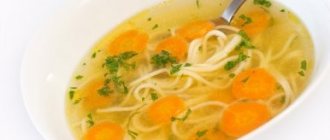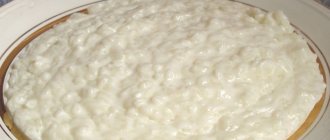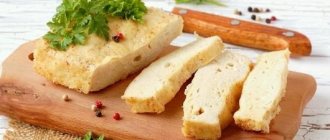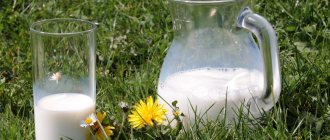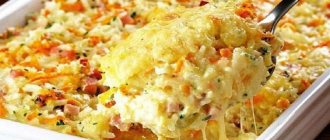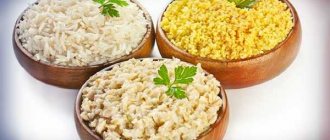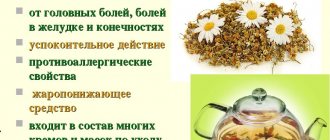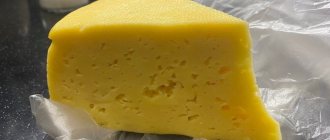Nutrition for stomach and duodenal ulcers: approximate menu
The diet for stomach and duodenal ulcers has worked well despite the cure and complete destruction of the ulcers within 2-3 weeks. Restoring the gastrointestinal tract by removing the main pathogen does not mean that all its functions will soon be normalized. If you have had this disease with prolonged treatment, doctors strongly recommend following a healthy diet for stomach ulcers.
During the period of an ulcer in the stomach, the main damage is hydrochloric acid, so during this disease, try to remove foods that affect the secretion of gastric juice. To weakly stimulate secretion, it is worth including only healthy foods in the menu that will not worsen the condition of the body. To eliminate and prevent all influencing factors, it is worth learning about proper nutrition for stomach and duodenal ulcers, which can subsequently restore the health of the body
Basic nutrition rules
The diet for duodenal ulcers has its own distinctive features. Not only the range of products is important, but also the method of preparing them, the time of consumption, and the size of the portions. Therapeutic nutrition involves split meals. Some rules must be followed exactly as prescribed. Only by taking into account all the nuances will the process of healing the disease be accelerated, and you will feel significant relief from your condition.
The main principles of diet, as well as selection of foods for duodenal ulcers:
- meals should be frequent - approximately every 3 hours;
- food should not irritate the mucous membrane of the stomach and duodenum;
- the diet should have increased nutritional value and include a sufficient amount of fats, proteins, carbohydrates, mineral salts and vitamins (necessarily A, C and B vitamins);
- products included in the diet should not have a strong juice-containing effect;
- Eating very hot or cold food is prohibited; it should be at room temperature;
- it is necessary to reduce the daily consumption of table salt to 10-12 g;
- food should not mechanically irritate the gastric mucosa; try to eat all food in pureed form;
- One meal should not contain a large amount of food.
The main task in the treatment of gastric and duodenal ulcers is to restore the functioning of all processes occurring in the body. Ordinary milk copes well with this task, being one of the most useful food products for people with peptic ulcers. Milk contains a large number of substances necessary for the body.
Advice from a gastroenterologist
Diet is a very important part of successful treatment for peptic ulcer disease. However, we should not forget that the main cause of this pathology is Helicobacter pylori infection. Therefore, dietary restrictions alone are not enough, and the patient still needs to take several antibiotics and antisecretory drugs.
It is important to adhere to a diet not only during an exacerbation of the disease. The patient must understand that some foods can seriously damage his stomach and cause a new exacerbation. Therefore, after the symptoms have completely disappeared, new dishes are carefully added to the diet. And some restrictions (for example, regarding alcohol) remain for the rest of the patient’s life.
The diet must be structured in such a way that dishes are repeated as rarely as possible. If the patient's diet is varied, then the likelihood that he will strictly adhere to it is much higher. It is also necessary to ensure that he consumes a sufficient amount of nutrients, vitamins, and microelements.
Diet No. 1
Follow table 1. Diet No. 1 is the recommended standard for patients with peptic ulcer disease. During the period of exacerbation, for ten to fifteen days, adhere to “table 1a”, which involves eating foods in liquid or jelly form.
In the future, it is recommended to switch to “table 1b”, which corresponds to pureed and mushy food. During the period of stable remission, one should be guided by the rules of the standard “diet 1”, which provides for the loose consistency of products, their consumption in grated or well-chopped form.
Possible risks
If the diagnosis is made by a doctor and he also prescribes a diet, then the risks associated with diet No. 1 are minimal. It should be remembered that the diet cannot last forever, because... there are certain imbalances in the ratio of proteins-fats-carbohydrates in the direction of increasing the latter, designed to help the body get out of the pathological state. The average duration of the diet is 3-5 months, depending on the severity of the disease. Possible complications are associated with violation of following its rules and the discrepancy between the diagnosis and its goals.
[30], [31], [32], [33], [34], [35], [36], [37], [38], [39], [40], [41]
What can you eat?
Your diet should consist of foods that allow the stomach to produce hydrochloric acid in smaller doses.
Allowed foods for stomach ulcers:
- Bread: 1st and 2nd grade wheat, stale, crackers, dry biscuits.
- Dairy products: milk, cream, non-sour kefir, yogurt, non-sour cottage cheese and dishes made from it (cheesecakes, dumplings, casserole, pudding), non-sour sour cream.
- Meat: chicken, turkey, beef, veal. Chopped meat is better - cutlets, meatballs, boiled or baked meatballs. You can eat it as a whole piece, but boiled.
- Soups: vegetable, pureed, in a slimy broth with the addition of boiled vegetables; milk soups; soups with the addition of pureed meat, oatmeal soup, rice soup, with pureed cereals.
- Vegetables: zucchini, pumpkin, beets, carrots, cauliflower, potatoes. Better boiled or stewed.
- Fish: low-fat varieties - pike perch, perch, pike, cod, hake, navaga, etc. boiled, baked, in whole pieces or in the form of cutlets, in jellied fish.
- Eggs: up to 2 times a day, soft-boiled, in the form of a steam omelet or eggs in dishes.
- Mild cheese, grated.
- Greens: parsley, dill, etc.
- Porridge: semolina, oatmeal, buckwheat, rice, ground cereal.
- Pasta, vermicelli, boiled in water or milk.
- Ripe fruits and non-acidic berries: strawberries, raspberries, wild strawberries, baked apples or in the form of puree, jelly, compotes.
- “Doctorskaya” sausage, milk sausages.
- Unsalted butter with sandwiches or in dishes, vegetable oil - without frying.
- Sweet dishes: jelly, honey, jam, preserves, marshmallows, marshmallows.
- Warm mineral waters (all hydrocarbonate) are recommended, 50-100 ml 1.5 hours before meals.
- Drinks: weak tea with milk, vegetable juices (carrot, apple-carrot), juices from sweet fruits and berries 1:1 with water, rose hip decoction.
Read also
Meatballs in cream sauce
Meatballs in creamy sauce Ingredients: Beef – 250 g Pork – 250 g Loose buckwheat porridge – 0.5 cups Onion – 1–2 pcs. Butter – 2 tablespoons Raw eggs – 2 pcs. Cream – 1.5 cups Flour – 1 tablespoon Ground salt and pepper – to taste Method
Meatballs
Meatballs Meatballs with mushrooms and pine nuts Cooking time 1 hour, 20 minutes |ingredients:| Pork – 350 g, beef – 350 g, rice – 100 g, medium onions – 2 pcs., eggs – 2 pcs., tomato juice – 300 ml, champignons – 200 g, pine nuts – 2 tbsp. l., vegetable
Meatballs baked with eggplants
Meatballs baked with eggplants 500 g eggplants; salt; stale bun; 4 tbsp. spoons of vegetable oil; 4 onions; 375 g ground beef; 1 egg; 200 g canned tomatoes; 200 g sour cream; parsley and seasonal greens; 2 teaspoons capers; white ground
Meatballs
Meatballs? 400 g of fresh champignons? 4 potato tubers? 1 cup cooked rice? 1 onion, tomato, egg? 4 tbsp. l. vegetable oil? 3 tbsp. l. breadcrumbs? Bay leaf? dill greens? ground black pepper? salt Peel the mushrooms, wash them, boil them in
What can't you eat?
We exclude products that especially increase the release of hydrochloric acid. Prohibited foods for ulcers:
- Fresh rye and white bread, puff pastry and pastry products; it is better to eat dried bread.
- Fatty, stringy meats (pork, duck and goose).
- Strong meat, fish broths, mushroom and strong vegetable broths.
- Vegetables: white cabbage, onions, cucumbers, rutabaga, turnips, sorrel, radish, spinach, pickled and pickled vegetables.
- Smoked and fried foods, fried fatty, salted fish, canned food.
- Sour, unripe berries; sour dairy products.
- Ice cream, chocolate.
- Cereals: millet, corn, pearl barley.
- Fried and hard-boiled eggs.
- Spicy, salty snacks, smoked meats, canned food.
- Fat: lamb, beef, pork.
- Fried foods.
- Carbonated drinks, kvass, strong tea, black coffee.
- Spicy meat, mushroom, tomato sauces, spicy cheese, pepper, vinegar, garlic, mustard, horseradish.
Diet after surgery
The standard recommendation is to fast for up to two days for the initial healing of the sutures. In the future, the following requirements are adhered to.
- On day 3. The patient can eat in accordance with the 0a diet, provided that he does not have bloating. Meals are split, up to seven times a day. The consistency of the dishes is exclusively liquid or in the form of jelly. The first meal should be the smallest, in the amount of one teaspoon. In this quantity, the patient is offered hourly juices diluted with water, fruit jelly, and weak meat broth. Over the course of two days, the volume of a single serving is increased and the patient is transferred to six to seven meals a day.
- On day 6. Gradual expansion of the diet and bringing it to the standard diet of table No. 1 by introducing pureed porridges, slimy soups, soft-boiled eggs or in the form of a steam omelet.
The diet should contain the maximum amount of protein components and vitamins, while carbohydrates, especially simple ones, should be kept to a minimum. This will allow you to saturate the diet with the spectrum of nutrients necessary for the patient in a small portion size.
For dessert
Although common sweets in the form of chocolate or ice cream are not available to people with stomach diseases, they can still please themselves with sweet salads.
With cottage cheese
The use of low-fat cottage cheese is welcomed by experts, since this product contains a large amount of useful substances necessary for the body to counteract disease and function properly.
Cottage cheese is used in salads with fruit, crushed into small pieces. This action should always be used for the product, since large pieces will provoke the release of large amounts of saliva and gastric juice.
Cottage cheese casserole is one of the best options for dishes with cottage cheese for people with ulcers. Fresh cottage cheese must be baked (you can add fruits or vegetables to taste), then finely crumble before serving.
Menu during an exacerbation period
During the acute period of the disease, you must carefully monitor your diet. Steam or boil food; sometimes you are allowed to bake food. Use a slow cooker - you can use it to make many tasty and healthy dishes that do not contradict the principles of therapeutic nutrition.
- First breakfast. A few soft-boiled eggs, wash down with a glass of milk. Instead of milk, you can drink herbal tea.
- Lunch. Weak herbal tea, fruit juice or milk, fruit for a snack - a baked apple, banana or peach.
- Dinner. Oatmeal soup or oatmeal. As an option, you can use steamed chicken soufflé, as well as fruit or berry jelly.
- Afternoon snack. Creamy curd dessert, vitamin infusion with rose hips. If you want something sweet, you can eat low-fat yogurt.
- Dinner. Milk porridge with rice (pre-mashed), one glass of milk. Another option is vegetable puree or boiled chicken breast.
- After dinner. Before going to bed, it is recommended to drink a glass of milk again, do not eat anything else, so as not to burden the stomach.
Reviews and results
The diet has been significantly expanded in terms of products (vegetables are added in addition to cereals) and processing methods (baking is allowed). In this regard, it can be diversified with new dishes. Nutrition is prescribed for a long period, since it contains the physiological norm of protein and fat.
Feedback from patients indicates that dietary nutrition, when used over a long period of time, has a positive effect on the condition of the stomach: food digestion improves, heartburn and pain disappear, and pain in the intestines and pancreatic area due to their diseases does not bother them.
- “... In the event of a mild exacerbation of a peptic ulcer, I manage without a hospital - I already know my treatment and immediately switch on therapeutic nutrition. True, this causes some trouble for the wife - she needs to prepare steamed dishes and pureed soups. But she gets out of the situation - she cooks for everyone and at this time the whole family gets healthier. I’m already used to steamed cutlets, it’s bad that you can’t add spices to them. You can eat almost all cereals, mashed potatoes, well-cooked and pureed vegetable additives. True, there is a desire to eat fried and smoked food, but I try to resist for two months. I can’t do it anymore because I’m losing a lot of weight”;
- “... After a perforated ulcer I had to be on medical nutrition for a long time. In the hospital I was on a very strict diet, and when I was discharged home I ate Diet 1B for a week, and now I have expanded it. They told me to adhere very strictly until six months. Yes, I don’t mind, I was really scared of the perforation. Dietary restrictions affected my weight, I lost 6 kg. I will be very careful about my diet and treatment”;
- “...I have frequent exacerbations of ulcers because I smoke, eat irregularly and do not eat what I need, because I often go on business trips. When it’s completely unbearable, I go to the hospital, where Table 1B is prescribed, and at home I switch to a basic gastric diet. The doctor warned that the longer I follow it, the lower the risk of relapse. It’s very difficult for me to stick to it, probably because I’m already used to poor nutrition.”
Sample menu
Diet for 2 days, designed for 1 person. Portion sizes are approximate. You can reduce or increase them, depending on how you feel.
- Breakfast: sandwich (white wheat bread with butter) - 1 piece; yogurt - 100 g; mineral water without gas - 200 ml.
- Second breakfast: soft-boiled eggs - 2 pcs.; rice porridge - 150 g; fruit puree - 100 g; milk - 200 ml.
- Lunch: chicken soup - 250 ml; cutlet; boiled pasta - 100 g; white bread - 1 slice; fruit soufflé - 100 g; applesauce - 100 g; dried apricots (soaked in water) - 3 pcs., milk - 200 ml.
- Afternoon snack: steam cutlet - 150 g; mashed potatoes - 150 g; white wheat bread - 1 slice; raisins (soaked in water) - 40 g; rosehip decoction - 200 ml.
- Dinner: boiled beef - 150 g; soft-boiled eggs - 2 pcs.; vegetable salad - 150 g; white wheat bread - 1 slice; fruit jelly - 100 g; milk - 200 ml.
Second day:
- Breakfast: sandwich – 1 pc. mineral water without gas – 200 ml.
- Second breakfast: steam omelette of 2 eggs; semolina porridge – 150 g; tea with sugar – 200 ml.
- Lunch: vegetable soup - 300 ml; beef meatballs - 1 50 g; green peas - 100 g; jacket potatoes - 100 g; white wheat bread - 1 slice; fruit jelly - 100 g; tea without sugar - 200 ml.
- Afternoon snack: oatmeal porridge - 200 g; white wheat bread - 1 slice; milk - 200 ml.
- Dinner: boiled fish - 150 g; vegetable puree - 100 g; soft-boiled egg - 1 pc.; white wheat bread - 1 slice; milk - 200 ml.
If the peptic ulcer is quite severe and you are experiencing severe pain, it is best to stick to the above menu.
MEAT MEATBALLS
Products: per 100 g: meat 145 g, wheat bread or loaf 20 g, butter 6 g, carrots 15 g, onions 6 g, cabbage 25 g, meat broth 140 g, parsley root 3 g.
Chop the vegetables, pour in the broth and simmer over low heat until tender. While the vegetables are stewing, cook the meat. Pass the meat pulp together with the loaf soaked in water through a meat grinder twice. Add a tablespoon of warm water and melted butter to the prepared minced meat and mix everything well.
From the resulting mass, roll into meatballs weighing 40–45 g and lower them into the broth with vegetables for about 20 minutes. After cooking the meatballs, the vegetables can be used as a side dish.
This text is an introductory fragment.
Continuation on liters
Nutrition during recovery
The principle of any therapeutic diet for peptic ulcers is as follows: the menu should include food that does not affect the walls of the affected internal organs either chemically, thermally, or mechanically. If you feel pain after eating any food, remove it from your diet.
- First breakfast. Omelet or steamed eggs prepared using two eggs or semolina with milk. Wash it down with a glass of milk.
- Lunch. Weak tea, milk or warm creamy cocoa. You can snack on fruit: banana or peach.
- Dinner. Milk soup with crushed rice, a piece of steamed meat, a small portion of mashed potatoes. For dessert - fruit jelly.
- Afternoon snack. A glass of rosehip infusion, a few crackers. Also eat jelly or cheesecake if you want something sweet.
- Dinner. Steamed curd soufflé, fruit jelly or fruit drink. Another option: rice patties with chopped lean beef or stewed zucchini.
- After dinner. Milk, a light salad of prunes and boiled mashed beets.
A properly chosen diet restores gastric secretion, relieves inflammation and irritation of the mucous membrane of damaged internal organs of the gastrointestinal tract, and also promotes rapid and painless healing of peptic ulcers. Use the tips described above and you will be able to help your body fight the disease and avoid possible negative consequences.
Benefit
Any diet must satisfy a person’s nutritional needs to accumulate energy to lead a full life. The benefit of diet No. 1, in addition to this function, is to provide nutrition that is gentle on the gastrointestinal tract. It protects the gastric mucosa from temperature, mechanical and chemical damage, normalizes the acidity of the stomach, improves its motility, reduces inflammatory foci on the mucosa, promotes the healing of ulcers and erosions, and has a beneficial effect on intestinal function.
[12], [13], [14], [15], [16], [17], [18]
Cooking recipes
The range of permitted and prohibited foods for duodenal ulcers is only at first glance frightening with a large number of changes in the usual diet. Dietary food is a special section of cooking. From a simple set of products it is easy to prepare many tasty and healthy dishes. The main thing in this case is to adhere to the rules for processing and consuming individual ingredients. Here are some delicious and easy recipes:
- Diet pumpkin pudding. To prepare the dish you will need: 150 g pumpkin pulp, 10 g semolina, 10 g honey, 20 g low-fat milk, 140 g apples, 2 eggs. Grind the apples and pumpkin in a blender. Add semolina and milk, bring the mixture to a boil. Add honey and beaten eggs to the prepared mixture. The pudding should be prepared by steaming or in a slow cooker.
- Oatmeal with pumpkin. For 1 cup of rolled oats, prepare 2 cups of skim milk, 1 cup of finely grated pumpkin pulp, butter, two tablespoons of honey. Boil oatmeal with milk until tender. Mix the porridge with pumpkin and leave the mixture for 10-15 minutes, covering the pan with a lid. Add a small amount of butter and also honey.
- Vegetable cream soup. To prepare this dish, prepare the following ingredients: potatoes, carrots, turnips, skim milk, butter. Select the quantity of ingredients at your discretion. Boil all vegetables and chop in a blender. To dilute the mixture to a puree consistency, use vegetable broth and milk. Before eating the soup, place a small piece of butter in the plate.
The duration of a gentle diet depends on the general well-being of the patient. If therapy proceeds without complications, there is a tendency towards recovery, and you can adjust your diet after three to four months. The standard duration of diet therapy is six months.
Healthy desserts
Many confectionery products are prohibited for ulcerative defects. It is clear that a logical question arises whether these products can be replaced with gentle products. For ulcerative pathology, the following sweet foods are allowed:
- honey, preferably acacia;
- agar This dessert is a carbohydrate mixture obtained from seafood in the form of a jelly;
- marshmallows and marshmallows made from natural ingredients.
In addition to these healthy delicacies, you can prepare your own dessert.
Baked apples
Required:
- 6 medium sized apples;
- sugar or powdered sugar.
Wash the apples and make an incision in the tail area so that the core is partially removed. Then, 0.5 teaspoons of sugar or powder are poured into each fruit, the apples are placed on a baking sheet and baked for 40 minutes in the oven at +180C.
Cottage cheese pudding
One of the most delicious and nutritious desserts allowed for ulcer sufferers. To prepare the pudding you will need:
- skim cheese;
- semolina at the rate of 1 tbsp. spoon for 100 gr. cottage cheese;
- a glass of milk;
- egg;
- sugar to taste;
- butter for greasing the baking sheet.
First, take semolina and pour milk, stir well and let it brew for 20 minutes. At the same time, beat cottage cheese with egg and sugar in a blender. If desired, you can add some raisins. If you plan to add dried fruits, you need to pour boiling water over them for 5-7 minutes, then remove them and add them to the curd mass. Next, semolina with milk is added to the future pudding, mixed and placed on a greased baking sheet. Baking time 45 minutes at 180C.
Important: Curd casserole is also useful for ulcers. It is prepared from apples, low-fat cottage cheese and semolina.
If the pathology in question is at the attenuation stage, you can consume low-fat cottage cheese in its pure form in small quantities. Instead of sugar, add a little honey. Such food is a valuable source of protein. In addition, cottage cheese has a positive effect on the functioning of the digestive system and protects the mucous membrane from the negative effects of gastric secretions.
Apple soufflé
An excellent alternative to rich desserts is apple soufflé. It is prepared as follows:
- apples;
- egg whites at the rate of one white per apple;
- a glass of milk;
- sugar to taste.
The apples are washed, peeled, and the resulting pulp is twisted in a meat grinder. Whipped whites with sugar and milk are added to the finished puree. Everything is mixed, laid out in a thin layer on a baking sheet and baked in the oven for 15 minutes at a temperature of +180C. Then, you need to carefully remove the baking sheet and check the soufflé, if necessary, extend the baking time by 10-15 minutes. Before serving, apple soufflé can be sprinkled with powdered sugar or sour cream.
